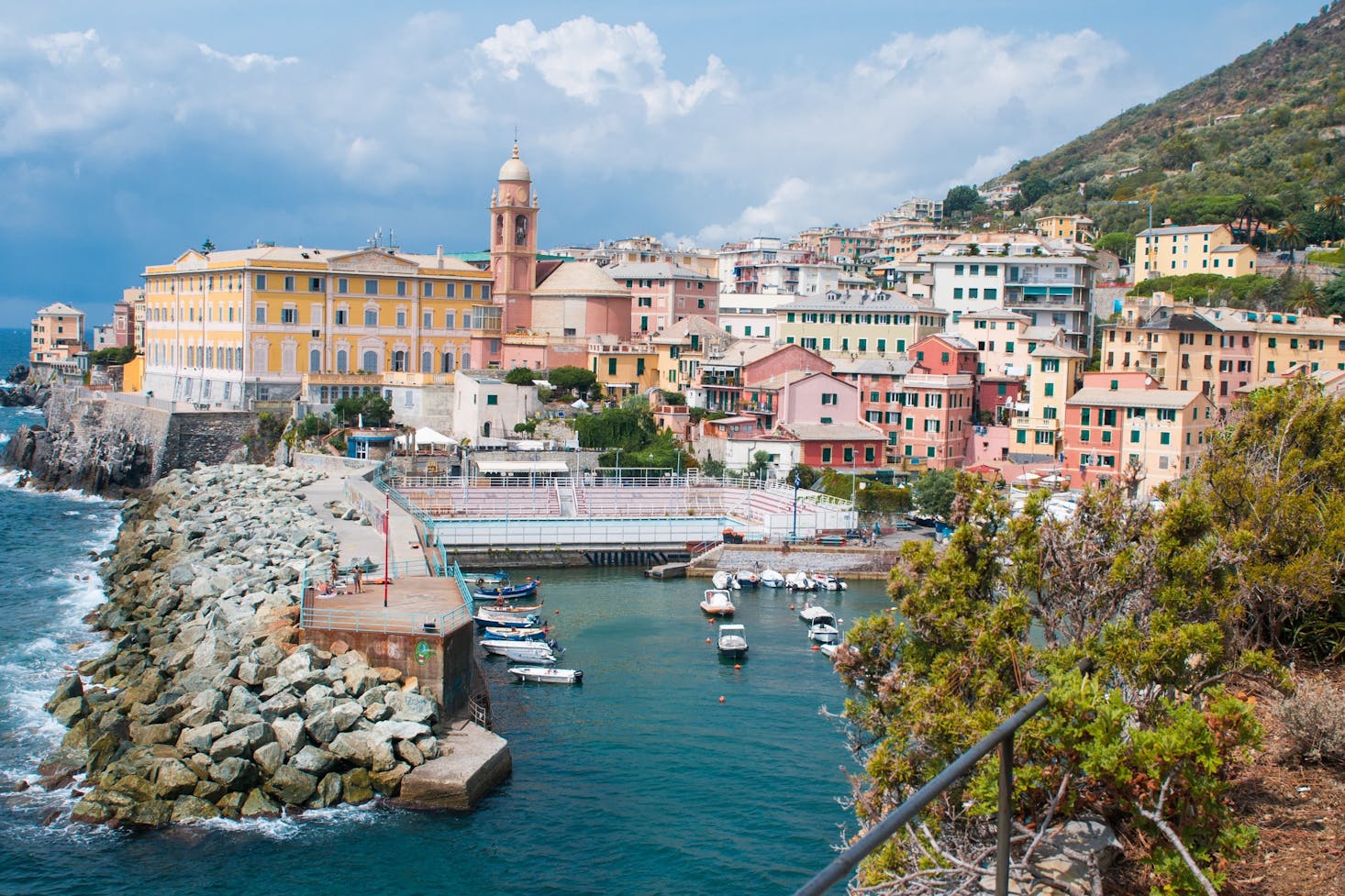What to Eat in Genoa: 10 Treats You Should Not Miss

The basic ingredients of the local Genoese cuisine are vegetables, olive oil, and aromatic herbs. Its authentic flavor is simple and well balanced, as evidenced by the dishes that the Ligurian capital is known for, such as focaccia and creamy pesto. With a dash of creativity, a simple Genoa dish can turn into a flavorful and enticing delicacy that locals are proud to serve to their guests.
As home to one of Italy’s most important seaports, it’s not a surprise that Genoa is also famous for its fresh seafood. You can buy freshly caught fish in local markets or order high-quality sea specialties, such as Genoese-style stockfish and capponada, in numerous restaurants.
For herbivores wondering what to eat in Genoa, this city has everything, no matter your dietary requirements, taste, or budget. Plenty of vegan and vegetarian restaurants in Genoa serve mouthwatering dishes that even your carnivore friend will enjoy. However, no culinary adventure is complete without trying the best street food in Genoa, like the savory farinata, or the inevitable Christmas classics, including ravioli alla Genovese and pandolce.
As soon as you arrive, drop off your bags at a luggage storage service in Genoa. Then you can stroll through the city center without burden, explore the historical shops and food stalls around the old town, and grab a bite. Start ticking off the food items on your list and fully enjoy your culinary adventure.
Get $5 off with the Bounce app
Use Bounce to find nearby bag storage in 4,000+ cities worldwide.
Get the app
Genoa Food: Pesto
Pesto is a famous sauce used all over the world, but its origin can be traced back to the mid-19th century. It originates from Genoa, which name comes from the Italian word pestare, meaning to crush or to pound. It refers to the way this local sauce is prepared using a mortar and pestle. But instead of pounding, today’s cooks make pesto by crushing the ingredients using a blender or food processor to speed up the process.
The main ingredients for making pesto sauce are fresh basil, pine nuts, parmesan cheese, extra-virgin olive oil, garlic, pecorino cheese, and salt. While you can make your own version at home or sample pesto in many countries around the world, nothing can compare to the authentic pesto Genovese.
The key component is the Genovese basil DOP, a highly sought-after flavor that holds a special place in the heart of Italian cuisine enthusiasts. It’s an aromatic herb with a sweet taste that makes the best pesto in the world. It’s a perfect sauce that goes well with potato gnocchi, lasagna, or trofie, a short, thin, and twisted traditional Ligurian pasta.
Genoa Food: Focaccia alla Genovese
Genoa’s common finger food, Focaccia is a flat bread that can either be savory or sweet. It has a long history and shares a common ancestry with Greeks, Etruscans, Egyptians, and even the ancient Levantine. In Italy, the region of Liguria is best known for focaccia or fugassa in Genoa. It’s a vital Genoese delicacy and maintains a strong relationship with the city’s story.
The origin of Genoese fugassa is still a mystery, but it has since been a must-eat food when visiting the Ligurian capital. The way it’s prepared has changed over the centuries, and every bakery makes its own variety. But no matter where you go, the primary ingredients remain the same: wheat flour, yeast, water, and olive oil.
Try the famous cheese focaccia, a food specialty in Recco, a small seaside town in the province of Genoa. It is made with flour, Ligurian olive oil, salt, and water and filled with cheese before baking in the oven. You can eat it as a snack, breakfast, or food on the go when touring Genoa.
Genoa Food: Farinata
Some say that farinata is a close relative of focaccia. Although there are similarities, these two flatbread dishes are unique in their own way. Farinata’s traditional recipes include chickpea flour, herbs, and extra-virgin olive oil. Then it is shaped into a pancake and sprinkled with black pepper.
Farinata is moist and soft inside yet crispy on the top. It’s inexpensive, making it a favorite street food in Genoa and throughout the Ligurian region. You can also enjoy it as a tasty snack or appetizer, and it goes well with aged cheese and crisp white wine.
This Genoese dish may seem to have medieval origins, but it was featured as a breakfast for port workers in the 16th century. Different versions of farinata today can be traced along the coast from Genoa to Pisa, Versilia, and Livorno.
Genoa Food: Pansotti
Pansotti is a more modern pasta recipe typical of Ligurian cuisine. It is similar to ravioli, stuffed with a combination of nutmeg, cheese, and a mix of edible wild plants the locals call prebuggiun or preboggio. The pasta is served with walnut sauce, which symbolizes the food and flavors of Liguri. Apart from the herbs and cheese, you can also stuff it with ricotta cheese, eggs, marjoram, and other greens.
The pansotti dish was first mentioned in print in 1931 in an Italian gastronomic guide. It was published by Touring Club Italia, referring to a recipe for pansoti cu a salsa de nuge from the Rapallo town on the Italian Rivier. The recipe, written in a local dialect, means pansotti with walnut sauce.
In some areas of Liguria, pansotti is shaped as half moons or triangular ravioli. But in the Metropolitan City of Genoa, the pasta is typically shaped like a large tortello or tortellini.

Genoa Food: Capponada
There are only a few salads in Liguria with ingredients that represent the region, and one of them is capponada. Also regarded as the Ligurian sailor’s salad, this is a refreshing seafood dish that’s easy to make and store for long sea voyages.
The key ingredient for capponada is Galette del Marinaio or the sailor’s crackers. But if you don’t have this thin, round cracker at your disposal, you can always use toasted bruschetta bread instead. The second primary ingredients are salted or fresh anchovies and sun-dried fish fillet, or mosciame. Mix them with olives, capers, tuna fish roe, olive oil, and a bit of vinegar to add flavor to the salad.
Some people attribute its origin to Camogli, a small fishing village on the Ligurian coast close to Genoa. Today, it’s easy to find capponada with basil leaves, hard-boiled eggs, and fresh tomatoes for a healthier combination.
Genoa Food: Ravioli
You can’t visit Genoa and not try ravioli, one of the famous pasta dishes typically eaten on special occasions. Genoese-style ravioli is a Christmas favorite filled with a mixture of endive, borage, and meat. Usually, locals serve it with tocco, a meat sauce called tuccu in the Genoese dialect, hence the name ravioli al tocco.
Ravioli is a timeless traditional dish in Italian cuisine. It's humble and doesn’t require intricate or hard-to-find ingredients. You only need meat or vegetables and cheese, which are common food elements. But filling can also include pears, nutmeg, and parmesan cheese.
Families usually serve it with their loved ones and as an essential dish on the Christmas table. Even today, Italians still practice the tradition of making this type of pasta for a feast using ingredients available in their area.
Genoa Food: Stockfish alla Genovese
If you love seafood, be sure to taste stockfish alla Genovese, a delicious fish dish typical of the region of Liguria in Northwest Italy. It’s a one-pot classic made by cooking different ingredients in a single pot. It includes dried cod cooked with pine nuts, olives, and various vegetables in a rich tomato-based broth. It was once a meal for the peasant but has eventually made its way to every family’s home and modern restaurants.
This stew is one of Genoa’s oldest fish recipes, and it’s so popular in Genoa that would be quick to assume that it hails from Liguria. However, that’s actually not the case. This dried cod item is Norway’s national pride, but over the centuries, it has become ingrained in Italian cooking and culinary traditions.
In Badalucco, a small medieval town in Imperia, about a hundred kilometers southwest of Genoa, a stockfish festival takes place each year in the month of September. It’s a big celebration to commemorate the time in the Medieval era when the townsfolks survived a siege by just eating stockfish. It only shows that this fish stew is deeply rooted not only in the Genoese kitchen but also in Italian cuisine.
Genoa Food: Torta Pasqualina
A dish originating from Liguria, torta pasqualina is a double-crusted delight that is sure to fill your belly and appease your taste buds. It’s a traditional Easter dish in Italy made from healthy ingredients like spinach, eggs, and cheese. You can also add nutmeg, ricotta, onion, and garlic for added flavor.
The original recipe contains artichokes, but many famous versions of the pie use chard leaves. Then you will need puff pastry to make the pie, though traditional recipes feature a strudel-like pastry, which is rolled thinly into a large circle.
It may seem a tricky process, but making torta pasqualina is easy and only needs simple ingredients. The finished product looks and tastes amazing. What you’ll want to see after slicing a piece of the pie are the cooked eggs throughout the ricotta and spinach filling.
Genoa Food: Cappon Magro
Are you a fan of seafood and love eating healthy? If so, then cappon magro is one of the best Genoa foods you shouldn’t miss. It’s a seafood and vegetable salad typical in the city of Genoa. It was invented as a dish for the poor, consisting of fish and leftovers. Over the years, cappon magro became one of the most festive delicacies of Ligurian cuisine and is now regarded as the king of the Italian Riviera’s seafood salads.
Cappon magro is truly a feast of the senses. Even if you’re not a seafood- or veggie-lover, your mouth will water as soon as you set your eyes on this dish. It is simple and meatless, with anchovies and tuna as a base. More modern variations involve alternating layers of different vegetables and seafood items, like prawns or shrimp, anchovy, and cod fillets. Then, it is dressed with a rich green sauce and decorated with capers, olives, eggs, and vegetables.
Cappon magro isn’t a typical dish you’ll often find in people’s homes. While it’s rarely prepared at home, you might get lucky to sample a plate on holiday. The best restaurants in Genoa may also have it on their menu, so don’t be afraid to ask around when visiting the city.
Genoa Food: Pandolce
If you’re looking for sweet treats during your gastronomic adventure in Genoa, try pandolce. This sweet bread is one of the city’s culinary symbols, originally served on special holidays, like Christmas and New Year’s Day. Nowadays, anyone can enjoy it year-round, as it can easily be found in bakeshops throughout the city and the region.
The traditional pandolce Genoese recipe features eggs, honey, olive oil, flour, and yeast. It also involves a generous dose of raisins and is flavored with orange blossom water and fennel seeds. Over the years, honey was replaced with sugar and butter took place of olive oil. In addition to raisins, modern cooks have also added candied fruits and pine nuts instead of only using raisins.
Discovering Ligurian Cuisine
Perhaps, you’re traveling for the first and unsure what to eat in Genoa with tons of food options available. You might be a returning visitor or working in the capital of Liguria and want to explore other traditional dishes you haven’t tried before. Regardless of the case, this Genoa food guide should help you pick several classic Genoese cuisine and traditional recipes to add to the list of Ligurian food and delicious treats you shouldn’t miss.
And don’t worry about those extra calories you’ve accumulated after consuming tons of Italian pasta dishes, sweets, or street food. If you want to ensure you get enough exercise and physical activity during your food tour, try some of the best hikes in Genoa. You can tackle easier routes or push yourself with the more challenging climbs to maximize the experience. Another option is to head to Genova Piazza Principe. This train station can take you to nearby destinations or be a starting point for things to see in the area, like the architecture of Via Garibaldi. Enjoy the food and the sights!
Get $5 off with the Bounce app
Use Bounce to find nearby bag storage in 4,000+ cities worldwide.
Get the app
